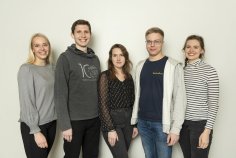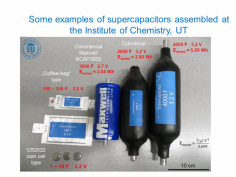Chair of Applied Electrochemistry
Applied electrochemistry is an interdisciplinary specialty based on chemistry, physics, and materials science, applied in a wide range of high-tech fields, including energy conversion and storage.
Research topics
Preparation of thin-film complex metal hydrides for reversible hydrogen storage
PhD Rasmus Palm, Kenneth Tuul, PhD Riinu Härmas, Miriam Koppel et al

The development of new effective molecular hydrogen (electric energy) storage methods is inevitable for a wide-scale hydrogen economy in addition to traditional hydrogen storage methods applicable at the time present. Storage of hydrogen under high pressure (1050 bar under development and testing stage now ) needs many energy (total 22-25 % of hydrogen compressed), special high-pressure systems and vessels, and is, therefore, a somewhat inefficient method. Hydrogen turns into liquid hydrogen and needs even more energy (up to 30-33 %).
Hydrogen storage in thin-film carbon membranes is an energy-efficient method but the volume needed for hydrogen storage is comparatively big. Therefore, the hydrogen storage in thin metal complex hydrides deposited onto/into micro-mesoporous thin-film layered carbon materials is under very intensive studies. After detailed experimental studies, the complex material synthesis procedure was worked out and it was demonstrated that the hydrogen is already released at a very low temperature, from 60 to 120 oC. The adsorption /desorption kinetics is fast, but there are some methods for improving the reversibility of adsorption/desorption processes. Thus, future materials optimization studies can give new complex materials, where the energy and storage efficiency are future increased.
It should be stressed that the complex metal hydrides deposited onto /into porous supports are nearly explosion-free materials differently from highly pressurized hydrogen tanks.
Development of electrical double layer supercapacitors
PhD Alar Jänes, PhD Thomas Thomberg, PhD Ove Oll, PhD Tavo Romann, prof. Enn Lust et al

Development of electrical double layer based supercapacitors (EDLC) started at 1991, when the very rough carbon and glassy carbon electrode electrochemical characteristics have been studied in acetonitrile +LiClO4 or NaBF4 electrolytes. In addition the single crystal carbon electrode studies started. In 1997, the Tartu Technologies OY has been established and Alar Jänes, Gunnar Nurk ,Mati Arulepp, Priit Nigu and Enn Lust have been hired by Tartu Technologies for development of electrochemical conditions of studies and applicability regimes of carbon micro-, mesoporous electrodes prepared from binary silicon , titanium and other binary carbides. Very intensive cooperation has been taking place up to 2005. There after some contacts were sustained up to now. Starting from 2008 the micro-mesoporous carbons have synthesized from many organic materials starting from glucose granulated white sugar, Estonian well decomposed peat, from lignine and from coffee beans (including used beans). Very high power density EDLC have been completed using different organic solvents (acetonitrile, mixture of ethylene and methylethylcarbonate,etc) with addition of triethylmethyl ammonium tetra flouroborate, or tetraethylammonium tetrafluoroborate salts. Region of ideal polarizability, limiting capacitance charging /discharging time constant, maximal power densities at fixed potentials have been calculated. Similar parameters for ionic liquid based systems have been established .Influence of organic solvents additions onto electrochemical characteristics of ionic liquid based EDLCs have been demonstrated. It was found that the addition of acetonitrile into RTILs decreases the potential region of ideal polarizability of EDLCs nearly 200 mV.
The sol gel method has been used for preparation of highly mesoporous carbon electrodes and very high power densities have been measured for highly mesoporous carbons based EDLCs. Electropolymerization effects under overpolarization conditions of electrodes have studied.
If was demonstrated that the electropolymerization effect can be used for avoiding of the detonation of supercapacitors as well as Li-ion and Na-ion batteries if the polymerizable additions are added into the electrolyte. This method has been patented in US and UK.
Development of hybrid supercapacitors
PhD Alar Jänes, PhD Thomas Thomberg, PhD Ove Oll, PhD Jaanus Eskusson et al

Hybrid supercapacitors (HSC) are energy storage devices where two different type of electrodes are used. In addition to electrical double layer based ideally polarizable electrode, where physical adsorption is taking place, there is second electrode where the faradic charge transfer reaction is occurring. This faradic reaction must have very high rate, but in reality there are only very few reactions, where the faradic charge transfer is quicker than the electrical double layer charging/ discharging process inside the micro-mesoporous electrode characterized by the characteristic charging/discharging time constant value. Thus, there is no real ridged frontier between EDLCs and HSC.
As the faradic charge transfer process is initiating very high capacitance (increase) effect, it can be used for increasing the energy density of HSCs. But as the rate of faradic charge transfer processes is usually not very high we are loosing highly in power densities possible to generate by HSCs. During last years the development of Zn /Zn2+ faradic systems has been under intensive development at UT. Lately, two to three times higher energy densities at moderate power densities were demonstrated, depending on the electrolyte used.
In addition the anions specific adsorption (I-; Br-, Cl-) based hybrid capacitors composed of different micro-mesoporous carbon electrodes and non-aqueous solvent and ionic liquid mixtures based electrolytes have been completed and tested under variable electrical load conditions. Based on the systematical analyses of experimental data it can be concluded that nearly 20-30% higher energy densities for completed HSCs have been achieved. It is interesting that there was no big decrease of power density observed for Zn/Zn2+ redox couple based HSCs. The faradic reaction capacitance and rate depend on the electrolyte, solvent and electrode material parameters therefore lot of optimization studies are inevitable to increase the power densities of hybrid capacitors under discussion.
Development of Li-ion and Na-ion batteries
PhD Ove Korjus, Annabel Olgo, PhD Alar Jänes, PhD Jaanus Eskusson et al

During many years various syntheses methods of very different carbon materials with variable specific surface area (from 30m2/g to 2250m2/g),well controlled hierarchical pore size distribution, very high micro –and mesopores surface area and micro- and mesopores volume, excellent electrical conductivity and geometrical shape of carbon particles has been worked out. In addition to carbide derived carbons, the glucose, white sugar and Estonian well-decomposed peat as raw materials were used for syntheses of different carbons under study by very novel physical analyses methods based on neutron beam and synchrotron radiation (beam) energies. It was found, that some highly graphitized carbon materials under study at UT can be used for moderate energy density Li-ion batteries (capacity up to 280-320 mAhg-1). However, the so-called hard carbon (HC) with spherical shape of carbon nanoparticles prepared from glucose, white sugar and Estonian peat derived carbons can be applied for very high energy storage (energy density 320-380 mAhg-1)) Na-ion batteries/ devices, where the energy storage is based on Na-ions physical adsorption. These energy densities achieved in 3 electrode setup are comparable with the best energy densities demonstrated for Li-ion batteries cathodes. However, differently from Li-ion batteries, very quick charging /discharging regimes can be applied for Na-ion batteries demonstrating that very high peak power densities can be collected it Na-ion batteries are installed into fluctuating PV or pulsating wind energy harvesting complexes. It was demonstrated that the Na-ion batteries characteristics depend very strongly on the electrolyte chemical composition (LiClO4, NaBF4, NaClO4, NaPF6) and solvent used (acetonitrile, ethylene carbonate, mixture of ethylene and methylethyl carbonate,etc).
Optimization of carbon nanostructure, electrolyte chemical composition, including solvent chemical composition (dielectric parameters) are under development stage at UT.
Synthesis, characterization and application of nanostructural nanowire polymer membranes activated with Ag, Cu, and Zn nanoclusters
PhD Thomas Thomberg, PhD Tavo Romann, PhD Andres Lust et al

This topic is very new for UT IC and started only at 2020. Initiated by COVID crises.0020The nanostructural viruses killing metal nanoclusters have been prepared by two different methods : using high-vacuum electromagnetron deposition method in ultrahigh vacuum or by co-electrospinning of polymers solution and metal salt solutions into high-voltage direct current field.Very actively killing face masks, activated with Cu nanoclusters, for Covid -19 virus have been prepared.
Different activities have been measured depending on the electromagnetic deposition regime applied. It is interesting that the face masks decorated with Ag nanoclusters were less active than the face masks prepared using Cu nanocluster materials.
The filtration materials for air cleaning systems have been prepared using modified electrospinning method where the polyvinylidenedifluoride (PVDF) in N,N dimethylacetamide solution as the nanowire forming solution and ZnCl2, and AgNO3 containing solutions have been used. For preparation of materials with various activities the electrospinning characteristics like electric field strength, solution feeding rate, polymer and metal salt concentrations were varied. Different physical methods like XRD, infra-red spectroscopy, XPS, SEM-EDX, HR-TEM combined with SAED and EELS, gas (BET) adsorption and Hg intrusion porosimetry methods have been applied for structural, porosity and chemical analysis of metals nanoclusters activated air filtering materials. The viruses killing/passivating parameters have been tested using H1N1 (human influenza A virus) strain. It was established that the Zn nanoclusters activated air filters have very high viruses killing activity differently form Ag nanoclusters decorated materials, having the lowest activity. It is interesting to stress that the Ag nanoclusters decorated material activity depends on the concentration of Ag deposited differently from Zn activated PVDF nanowires. Thus, future detailed virus killing activity studies are inevitable for optimization of air filter materials compositions under progress at the time being.
Courses
Lectures in Applied Electrochemistry, Energy Storage and Materials Technology, and Materials Chemistry in bachelor, master’s and doctoral studies. The current problems of modern electrochemistry are discussed. The principles and the most important applications of newer materials and energy storage devices are introduced.



